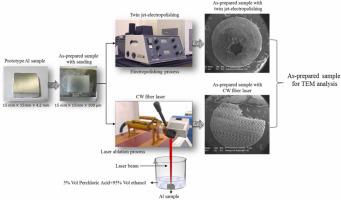Micron ( IF 2.4 ) Pub Date : 2023-09-02 , DOI: 10.1016/j.micron.2023.103535 Mohammad Jafari Eskandari 1 , Masoud Araghchi 1

|
The laser ablation process has been presented as a state-of-the-art and robust method for eliminating surface layers of metallic bulk materials on the micro/nanoscale with considerable accuracy and speed. These capabilities make it an ideal instrument for the primary step of metallic bulk sample preparation for transmission electron microscopy (TEM) analysis with minimal damage to the crystal structure of the sample. This work prepared a pure aluminum plate by fiber laser scanning immersed in a 5% perchloric acid and 95% ethanol (by volume) solution. The laser ablation in an acidic liquid condition was used in the chemical etching process, to prevent oxidation, minimize the heat-affected region, and induce crystalline defects. For this purpose, a continuous wave fiber laser with a power of 100 W, a wavelength of 1064 nm, and a focusing distance of 305 mm was applied. The TEM analysis for the as-prepared sample by the laser ablation process was compared to the standard jet electro-polishing method in the same solution. The results showed that crystal structure variations such as grain size and lattice defects did not occur in the aluminum sample due to the thermal effects of the laser ablation process. The average size of the grains and zone axis were about 600-800 nm and z=[011], respectively, in as-prepared samples by both methods; In addition, very few dislocations were observed in the grain boundaries and inside the grains. Therefore, based on the obtained results, laser ablation could be considered an eco-friendly, comfortable, fast, and cost-effective method with a small volume of chemicals used, compared to the standard jet electro-polishing method for the TEM preparation of the metallic bulk samples.
中文翻译:

通过在酸性液体中激光烧蚀制备用于透射电子显微镜分析的金属块状样品
激光烧蚀工艺被认为是一种最先进且稳健的方法,可以以相当高的精度和速度在微/纳米尺度上消除金属块状材料的表面层。这些功能使其成为透射电子显微镜 (TEM) 分析的金属块状样品制备第一步的理想仪器,同时对样品晶体结构的损害最小。本工作通过光纤激光扫描制备了浸入 5% 高氯酸和 95% 乙醇(按体积计)溶液中的 纯铝板化学蚀刻过程中采用酸性液体条件下的激光烧蚀,以防止氧化、最小化热影响区域并诱发晶体缺陷。为此,采用W、波长为1064 nm、聚焦距离为305将激光烧蚀工艺制备的样品与相同溶液中的标准喷射电抛光方法进行 TEM 分析进行比较。结果表明,由于激光烧蚀过程的热效应,铝样品中没有出现晶粒尺寸和晶格缺陷等晶体结构变化。在两种方法制备的样品中,晶粒和区轴的平均尺寸分别约为 600-800此外,在晶界和晶粒内部观察到很少的位错。因此,根据所获得的结果,与用于 TEM 制备的标准喷射电抛光方法相比,激光烧蚀可以被认为是一种环保、舒适、快速且具有成本效益的方法,且使用的化学品量较少。金属散装样品。



























 京公网安备 11010802027423号
京公网安备 11010802027423号